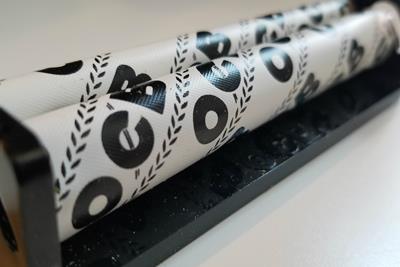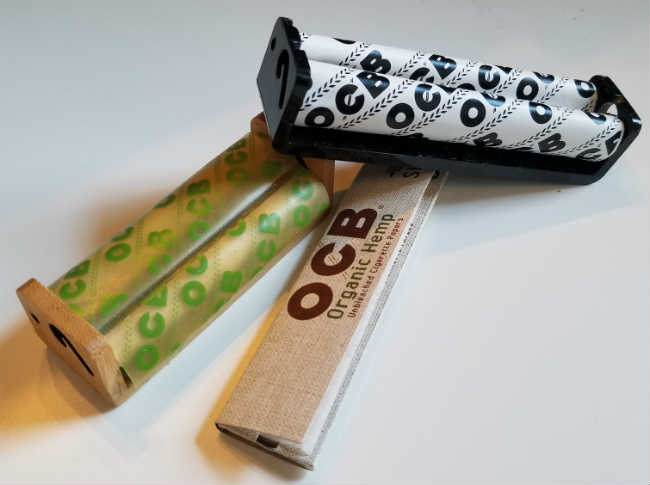
Tuesday November 30, 2021
 420 Culture
420 Culture
Though sometimes considered the training wheels of cannabis culture, the humble joint roller is an often-overlooked tool that deserves a place in any rolling aficionado’s kit. Though not ideal for every occasion, these simple accessories offer a few features unmatched by other joint-rolling methods.
Pros of Joint Rolling Machines
While they may not showcase your skills, joint rolling machines can get the job done quickly and efficiently. Here are some top benefits of opting to use a joint rolling machine:
Efficiency/Speed
Hand rolling more than a few joints can take a considerable amount of time. Joint rolling machines put out a joint in under a minute; about 20-30 seconds if you’re adept, and about 10 if you’re really familiar (and have ingredients prepared). It is by far the most efficient method outside of using industrial, specialized equipment to load multiple joints. If you want to try to skip the rolling altogether and opt for pre-formed cones, anyone who’s worked in a dispensary or packaging company will attest: stuffing individual cones in large batches is tedious work.

Many hand rollers appreciate the speed and ease of a good joint machine, reserving rolling by hand for times of relaxation. Machines are for quick and necessary demands. If you need a lot of jays in a hurry, a rolling machine is a good option.
Ease of Use
Joint rolling machines are incredibly easy to use, with simple instructions. There are few moving parts, most are quite durable, and require only minimal fine motor skills (which can be an issue for consumers with disabilities).
For those that haven’t mastered hand-rolling (or even ventured into it), joint rolling machines allow almost anyone to roll a joint with minimal time and energy invested.
It’s the first and easiest step to stop relying on others for your joint needs (either the more costly jays at a dispensary or bugging a friend to roll joints for you), and allows you to take control of your cannabis consumption. Sometimes, after a long day, it’s just easier to let the machine get it.
Uniformity
If you’re new to hand-rolling, your jays might not provide the most dependable cannabinoid delivery. They’ll likely be a little loose, with a bulge in the middle and a tendency to canoe. Using a machine, you’ll get the same nice joint every time.
While many mean it as a put-down, the “training wheels” description has some merit to it. Hand-rolling takes practice, so in the meantime, you’ll have something to fall back on. If you’re still getting up to speed and don’t have time, product, or papers to risk, consider a roller.
Inconspicuous and Standard Dosing
Although cannabis is gaining international acceptance, many still attach a stigma to larger, cone- shaped joints. The clean, uniform, cigarette-like appearance that joint rolling machines produce is simply easier to blend-in in social settings, and closer to what non-smokers are used to seeing consumed. The standard 1¼ inch size is a manageable size on the go that’s less likely to attract gawkers (though the smell still might).
Cons of Joint Rolling Machines
As useful as they can be, there are also some significant drawbacks to using joint rolling machines. All of that efficiency and uniformity will come at the cost of a lack of flexibility and customization. Let’s take a look at some of the most common complaints surrounding joint rolling machines:
Bad Joint Machines Roll Bad Joints
We highly suspect that most people against using joint rolling machines have only used poorly made ones, and poorly made joint rollers are everywhere, so it’s a decent guess. The key element to a joint roller is the rolling sheath. These can vary in material from high-quality synthetics to old-fashioned vinyl. The vinyl ones, while cheap and readily found, tend to roll joints unevenly or too tight. You’re left with a joint prone to canoeing and tough to draw; ultimately, less desirable to smoke.
Another thing to look for is that some cheaper joint rollers have a loose close, with a tendency to spring open if packed too tight. They’ll send flower flying if you even look at them wrong. Look for a firm close, but not too tight. A roller should be able to sit closed with product in it without you holding it clasped, but still roll freely.
All machines take a little trial and error to find the right fill amount, but if your joint roller is constantly making bad jays and flinging product at you, it’s worthwhile to ditch it for a better one. Joint rolling machines are fairly cheap, so if you buy one you don’t like, at worst you’re out $6-10.
User Error
Though joint rollers are easy to use, they still require a little bit of knowhow. One common mistake that people make when using a joint roller is an uneven fill. If the roller isn’t as filled on one end as the other, it will cause the roller to roll unevenly, resulting in a joint that’s too tight to smoke or burns unevenly. They seem straightforward once you get the hang of them, but operating a rolling machine for the first time without instructions isn’t very intuitive.
One Size Doesn’t Fit All
While joint rolling machines are consistent, they are also inflexible. Beyond a small amount of variation, the machines will require a set amount of cannabis each time. Many smokers adjust the size of their joints to whatever the intended occasion calls for – a big fatty for social occasions, or a pinner for a quick lift, etc.
Rolling machines typically come in two standard sizes, a 1¼” cigarette-sized standard, and 5” or “blunt”-sized. There are a few other non-standard sizes, like king size, so be sure to check that the roller you’re purchasing matches the size of your desired papers.
Handrollers can fit an impressive amount of flower in a standard joint paper, or almost nothing. As you progress in your pursuit of joint smoking, it’s likely that this one-size-fits-all won’t always cut it. If you don’t desire the size or shape that that machine makes, you’re out of luck.
The Stigma
People like to gate-keep the strangest things. Some cannabis enthusiasts look down on those who can’t or don’t hand-roll. If you’re among cannabis connoisseurs (or just a bunch of know-it-alls), it’s possible, even probable, that some snob will make a comment about a machine-rolled joint.
Sure, hand-rolling is a useful and enjoyable skill for any smoker to acquire, but it’s in no way necessary to enjoy the world of cannabis. If someone makes fun of your joint, feel free to not share it with them.
Conclusion
None of this is relevant if you can’t find a serviceable rolling machine, and finding a quality joint rolling machine can sometimes be a bit of a challenge depending on what head shops you have access to.
To this writer’s experience, OCB makes the best widely available rollers on the market. They have a smooth action, churn out quality jays, and the thermoplastic polyurethane (TPU) sheaths can last a few years on daily use. Specifically, the bamboo edition seems to work the best.
I want to be pretty clear here, that I’m in no way being compensated by OCB for recommending these, I’ve simply used about a dozen other rollers and this is the only one I went back and bought a second one of, after the first gave out two years into using it regularly.
There are products to be found above the OCB standard, but they may be difficult to come by for the typical consumer.
A key takeaway here is that the disdain that the common cannabis smoker has for joint rollers is uncalled for. Joint rolling machines are another tool in the cannabis toolbox, their utility can’t be denied. For making a quick jay, few things work better.
Frequently Asked Questions
Do Joint Rolling Machines Work?
Yes. A good joint rolling machine can output a uniform, well rolled joint in just a few seconds. Poor quality machines roll bad joints that roll too tightly, or roll unevenly, and are unpleasant to smoke, leading many to believe that joint rollers are not worth using. However, a well built joint roller can roll dependable joints every time.
How Do I Use a Joint Roller?
Put simply: First open the roller, and fill it with cannabis, then close the roller, give it a spin to form the joint (spinning downwards with the roller facing you). Feed a paper into the closed roller, leaving room at the end to wet the glue. Wet the glue, and do one more spin to seal the joint. Open and enjoy.
Who Makes the Best Joint Rollers?
This writer prefers OCB Bamboo rollers, however there are many good brands out there. Any good roller will have quality material for the sheath and will roll straight, even joints. If your roller hits those marks, well, look no further.
Are rolling machines useful or just lame? Weigh in below with your thoughts on rolling.







